Supply Side Platform Advertising Explained
Publishers who use supply side platform technology have seen their ad revenue grow by 55% since 2020. These numbers show why SSPs have become vital tools that power digital advertising today.
Supply side platform advertising makes it easy to sell digital ad inventory through multiple exchanges and demand-side platforms. Most publishers connect with about 5 SSPs or an independent trading desk like GeoSpot Media to handle their inventory. This setup enables live bidding that takes less than 100 milliseconds. SSPs help publishers control price floors, monitor performance, and deliver ads better across desktop and mobile.
The 2025 Supply Side Platform Scene
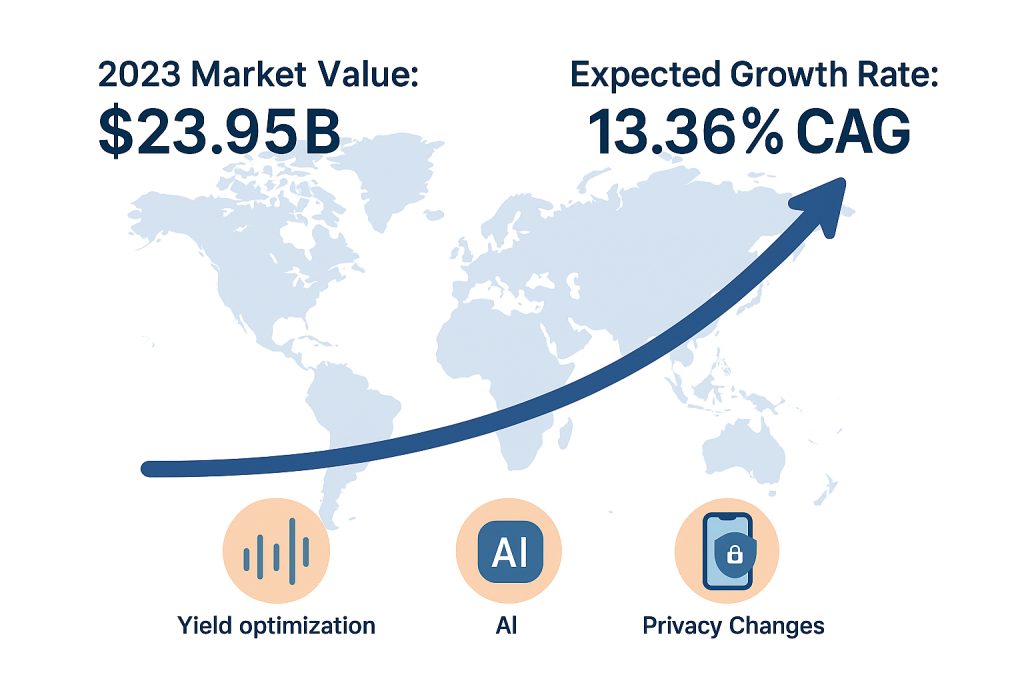
Key Market Changes Since 2023
The programmatic advertising landscape has undergone changes since 2023. Publishers now have new ways to interact with supply side platforms. Display advertising dominates the SSP market generating over 40% of global revenue. Video advertising shows the strongest growth due to consumers preferring video content across platforms.
Mobile advertising has become a key driver of growth for the supply side platform industry. As smartphone use increases worldwide, publishers now prioritize partnerships with mobile-optimized SSPs.
Header bidding has an impact on market dynamics. Publishers now have access to demand from multiple SSPs at the same time. This tech boosts fill rates and gives publishers more control over their inventory. Many people choose to deploy SSPs in the cloud because it’s cheap, can grow with you, and is simple to set up.
Privacy-First Advertising and How It Affects SSPs
Privacy worries have changed how supply side platforms operate. Firefox and Safari have already gotten rid of third-party cookies. Chrome plans to do the same, which means SSPs must adapt to a new way of targeting.
People value privacy more these days. SSPs now prioritize methods that respect privacy relying on first-party data and transparent consent processes.
SSPs develop new approaches to protect privacy while maintaining ad effectiveness. Recent industry studies show: “Publishers need SSPs to offer alternative techniques to boost yield using zero- and first-party data links, and to provide clean room technologies for safe identifier transactions”.
AI Has a Big Impact on Modern Platform Optimization
AI has caused a revolution in how supply side platforms develop. Key SSP functions now run on AI algorithms:
- Yield optimization – Machine learning models examine past performance data to tweak floor prices and increase publisher earnings
- Traffic shaping – AI systems analyze user behavior, interests, and engagement patterns to identify high-value users—those most likely to take desired actions like making a purchase or signing up.
- Bidstream analysis – Clever programs reduce waste tackling the 90% of bid requests that turn into useless traffic
How Supply Side Platform Advertising Works in Practice
Supply side platform tech handles millions of ad deals every day through automated systems. Each ad view involves complex interactions among publishers, advertisers, and tech middlemen. Let’s dive into the nuts and bolts that make supply side platform advertising tick.
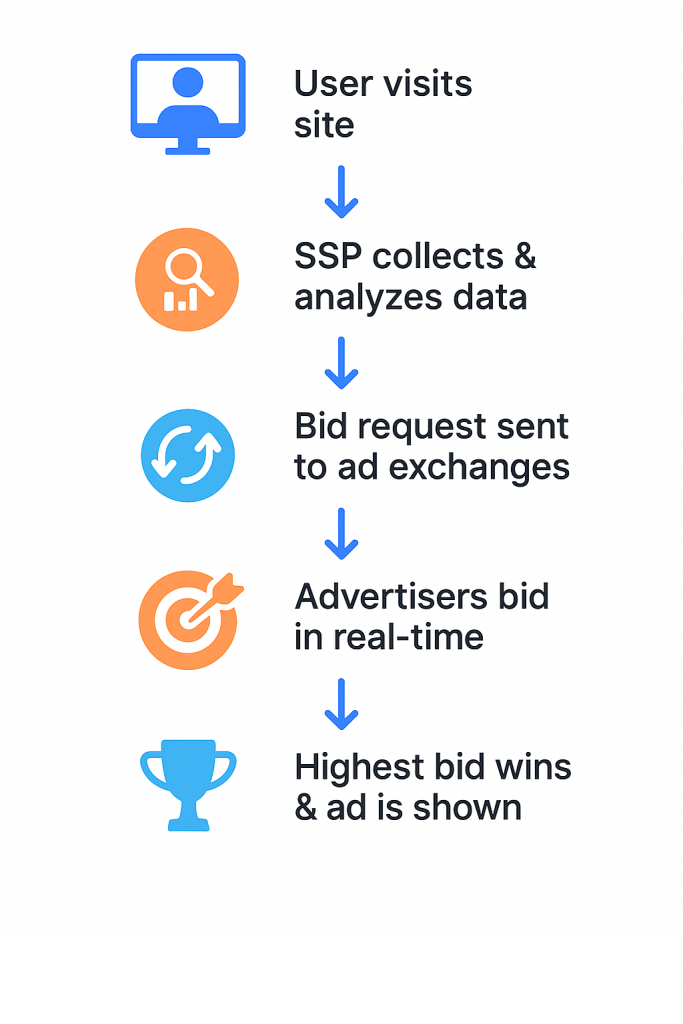
The Real-Time Bidding Process Explained
Real-time bidding (RTB) is the backbone of programmatic advertising. It allows buyers to purchase and place ads in split seconds as a webpage loads. The process follows several coordinated steps:
- Initiation: A user checks out a publisher’s website. The page tells the supply side platform about an open ad spot.
- Data Analysis: The SSP looks at user info like where they are and what sites they’ve visited. It also checks out things like age and gender when it can.
- Bid Request: This info goes to ad exchanges. These exchanges link up with lots of demand-side platforms (DSPs).
- Auction Execution: Advertisers start to bid based on how much they think it’s worth to reach that user.
- Winner Selection: The highest bidder comes out on top. Their bid goes to the publisher, and the user sees their ad
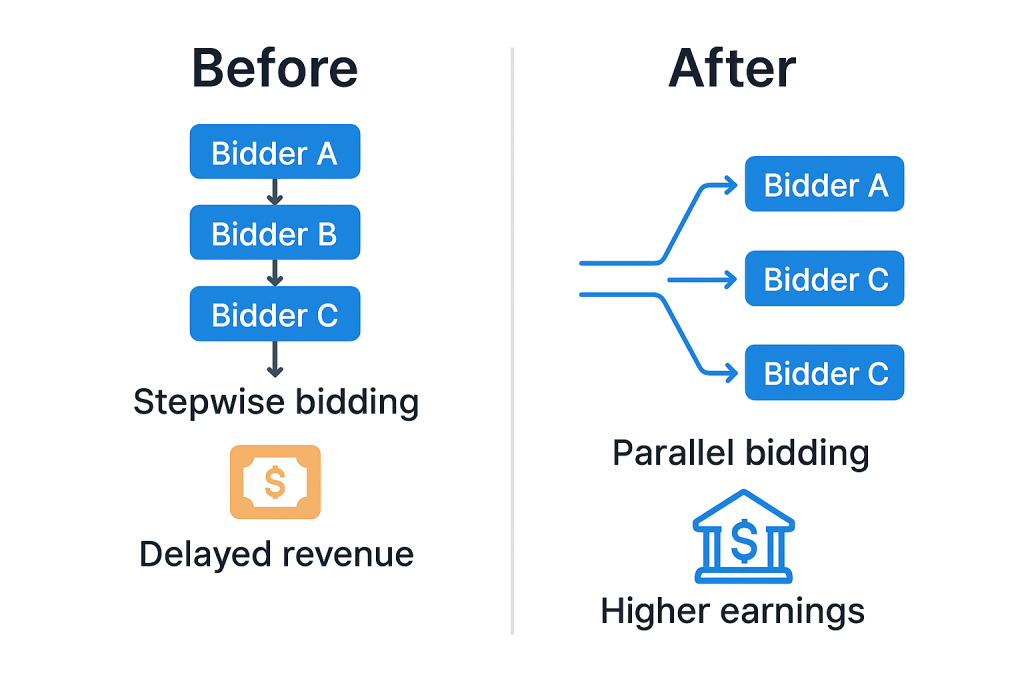
Header Bidding Integration with SSPs
Header bidding emerged to solve traditional ad serving issues. Publishers can now get bids from multiple sources at the same time before they call their ad server.
The header bidding wrapper handles three main jobs:
- It arranges potential buyers and establishes auction rules
- All partner bid requests begin at the same moment
- It handles auction timing and participation
Header bidding has an impact on fixing problems with older systems. Every potential buyer can bid at the same time in one auction, which leads to fair competition better access to top-notch inventory, and more money for publishers.
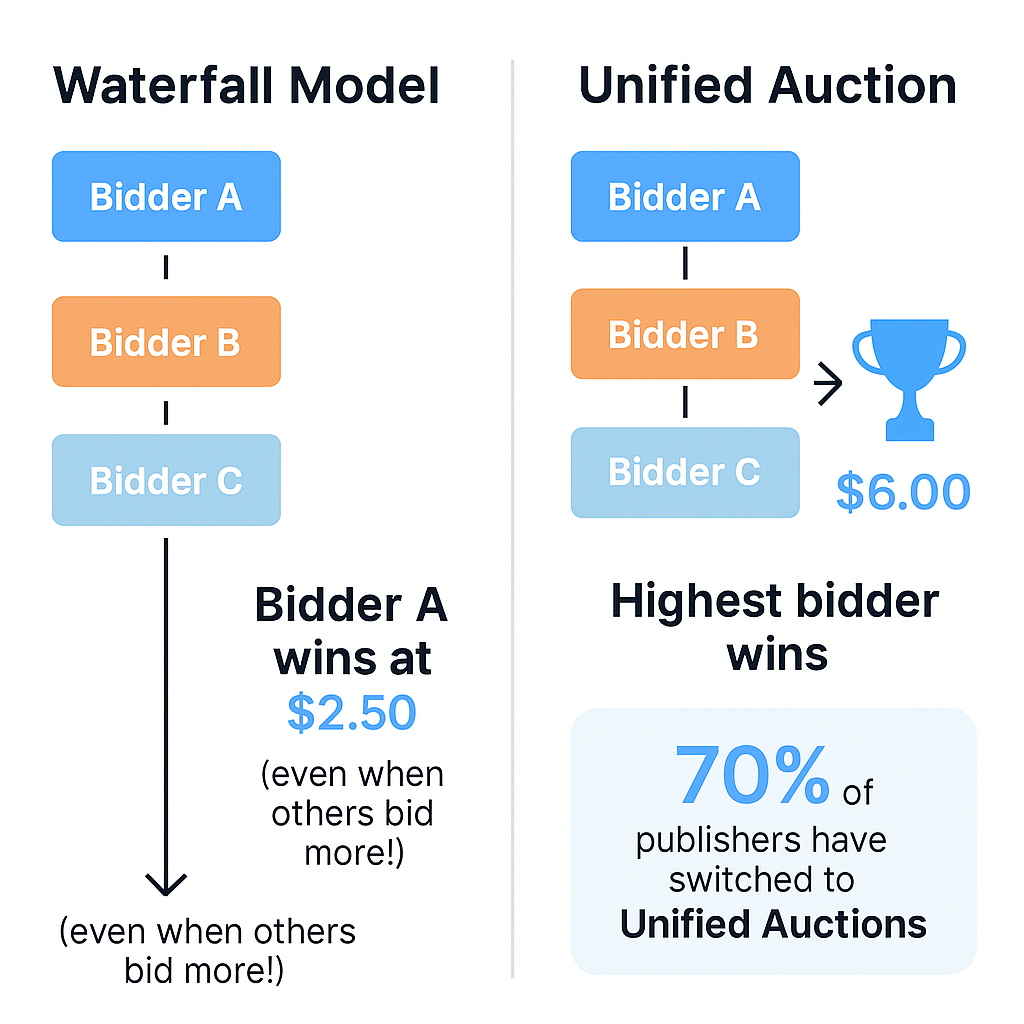
Waterfall vs. Unified Auction Models
The ad industry has moved from waterfall models to unified auctions changing how publishers earn money from their inventory.
The waterfall model ranks demand sources in order based on how well they’ve done before. When there’s an impression, the highest-ranked source gets the first chance to buy. If they don’t buy or meet the lowest price, the chance goes to the next source. This keeps going until someone buys or they run out of options.
A real-world scenario demonstrates why this approach falls short: Three bidders propose different amounts – Bidder A ($2.50), Bidder B ($4.00), and Bidder C ($6.00). In a waterfall setup of A→B→C, Bidder A emerges victorious at $2.50 despite others willing to pay more.
Unified auctions work differently. They allow multiple ad exchanges to access publisher inventory. All participants bid in a single auction, with the highest offer winning regardless of past performance. To illustrate let’s use the same example: a unified auction would allow Bidder C to win at $6.00 resulting in a 140% increase in revenue.
Key Features Publishers Should Look for in Top SSP Platforms
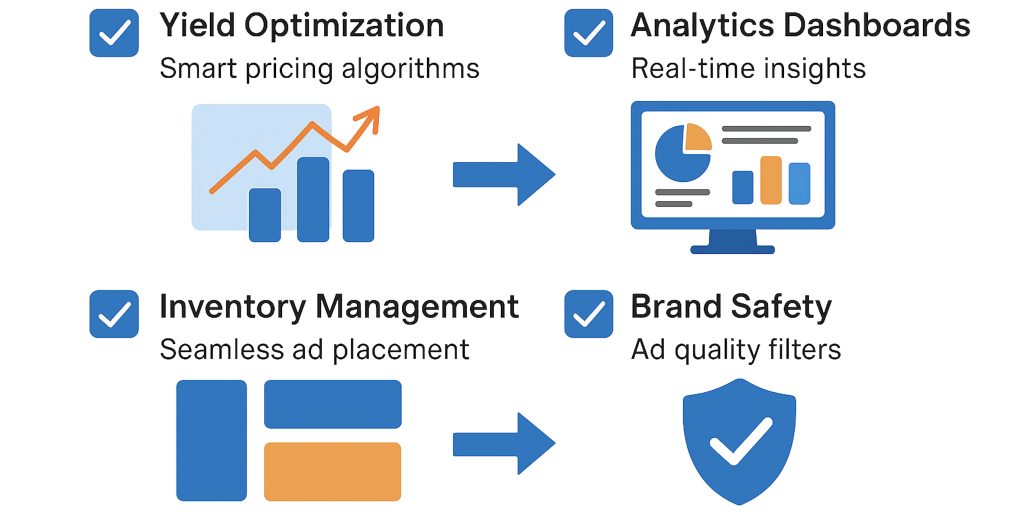
Publishers need to check specific features that affect how much money they can make and how they can work when picking the right supply side platform. They should focus on platforms that have four main abilities to get the most out of their advertising.
Advanced Yield Optimization Abilities
Yield optimization is crucial for supply side platform advertising to succeed. Today’s SSPs use smart math to look at past results and guess the best prices for different groups of people. These systems change ad space prices based on what the market wants, which helps make the most money from each ad view.
Key yield optimization features include:
- Floor price optimization mechanics that adjust the lowest acceptable bids based on previous results
- Fill rate management tools to ensure the highest inventory use
- First and second-price auction support to adapt to different market situations
- Dynamic pricing algorithms that react to changing advertiser requirements
Publishers aiming to boost their revenue should understand how each SSP’s yield optimization aligns with their current monetization approach.
Reporting and Analytics Dashboards
In-depth analytics enable publishers to make wiser choices about their inventory monetization strategies. Top-notch SSP platforms provide comprehensive reports on ad performance, user engagement, and revenue generation.
The most useful analytics dashboards offer publishers:
- Thorough understanding of click rates, view metrics, and who the audience is
- Personalized report tools with ready-made layouts and flexible time frame choices
- Real-time updates to examine recent happenings with little wait
- Job-specific screens that display useful info through key numbers and visual report overviews
The latest platforms show bidding trends exposing which advertisers purchase inventory and at what cost. This transparency allows publishers to identify revenue chances and examine how they distribute their inventory.
Inventory Management Tools
The best supply side platforms excel at handling ad inventory well. These tools help publishers arrange, group, and rank ad space across all types of digital channels.
Cutting-edge inventory management features include:
- Central control panels to make ad placement easier
- Systems to sort inventory by format, content type, and audience
- Smart systems that choose ad spots based on user actions and current demand
- Tools to limit how often users see specific ads
Header bidding integration has become essential when publishers offer their inventory to multiple demand sources at the same time. This technology has an impact on competition for impressions and often results in higher revenue for publishers.
Brand Safety Controls and Ad Quality Filters
Brand safety features protect publishers’ reputation by blocking unsuitable or damaging advertisements from their sites. These tools filter out ads that don’t meet certain standards, which protects user experience and keeps brand integrity.
Key brand safety components include:
- Systems to sort content that point out risky material
- Tools to spot and stop security risks that could harm computers
- Steps to check ads to make sure they’re good quality and fit well
- Ways to stop certain advertisers types of business, or ad styles
By taking a close look at each platform’s abilities in these areas, publishers can find solutions that align with their goals to make money and meet their audience’s expectations.
Top Supply Side Platform Companies in 2025
The digital landscape of supply side platforms has undergone significant changes in 2025. A few major players now dominate the market. Each platform offers publishers unique ways to maximize their ad revenue while navigating privacy regulations and emerging technologies.

Awmani serves as a powerful monetization platform, seamlessly connecting publishers with premium demand sources, including ad exchanges, networks, and platforms. Designed for efficiency, it automates the ad-selling process, freeing publishers to focus on content and audience engagement.
The platform stands out with:
- Real-time auction technology that maximizes revenue by analyzing impressions and driving competition among advertisers.
- Advanced inventory management tools that ensure seamless organization and alignment with brand objectives.
- Comprehensive reporting that provides in-depth insights into ad performance and revenue trends.
- Robust brand safety measures that filter out inappropriate ads, maintaining a high-quality user experience.
With Awmani, publishers gain full control over their ad strategy while optimizing earnings with minimal effort.

Google Ad Manager remains the most adopted supply side platform. It integrates robust ad server capabilities with sophisticated monetization options. They allow publishers to access Google’s extensive advertiser network and collaborate with numerous other ad exchanges.
The platform excels in these areas:
- Advanced reporting tools and easy-to-use dashboards
- Compatibility with various ad types such as display, video, and native advertising
- Built-in systems to prevent fraud and identify malware
- Simple integration with Google’s broader advertising ecosystem
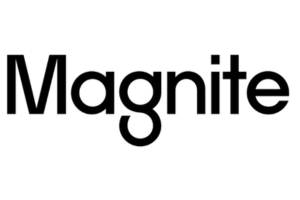
Rubicon Project and Telaria joined forces in 2020 giving birth to Magnite, which now stands as the biggest independent supply side platform in the world. The company operates two distinct platforms:
- Magnite CTV (Telaria) – made for connected TV ads
- Magnite DV+ (Rubicon Project) – manages display, video, and other formats like native, audio, and DOOH
Magnite has joined forces with streaming powerhouses Netflix and Disney.
Ways to Maximize Revenue with Supply Side Platform Advertising
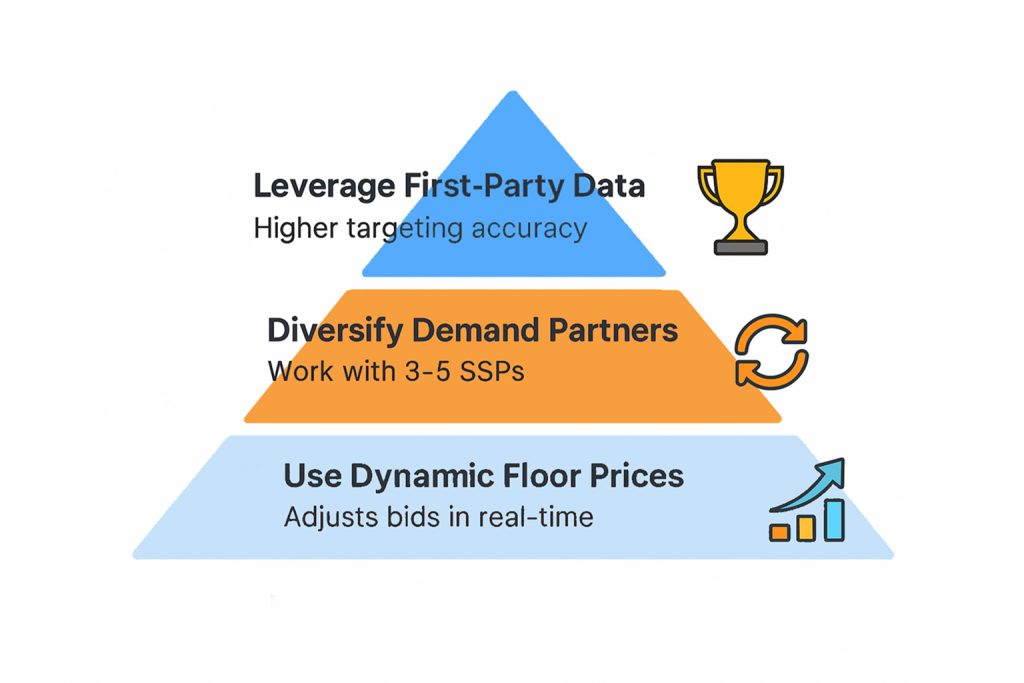
Publishers can increase their ad revenue by 10-40% through advanced technical approaches with supply side platforms. How well this works depends on the quality of inventory, brand recognition, and type of content. These approaches go beyond just picking a platform.
Methods to Optimize Dynamic Floor Prices
Price floors have a significant impact on signaling fair market value in programmatic auctions. Dynamic floor pricing proves more effective than static floors. It tweaks minimum bid thresholds using past performance data. This helps boost CPMs when demand peaks and keeps fill rates steady during slow periods.
A recent industry report notes: “A better approach is for SSPs to issue bid requests with floor prices that estimate the fair market value of the impression”. This all-encompassing strategy takes into account several key elements:
- Real-time data examination
- How deep users go in sessions and their behavior trends
- How the bid pool is made up and how dense it is
Publishers should gauge how well their floor pricing works by looking at RPM (revenue per pageview) or RPS (revenue per session). They can also check fill rates and bid patterns.
Demand Partner Diversification
In contrast to this push for unity, having a range of strategic partners boosts publisher revenue. Experts in the field suggest that 3-5 SSP connections are ideal for most publishers. This balanced approach creates a busy auction environment without overwhelming the system with queries.
Diversification makes sense because each SSP adds its own unique value through:
- Different agency and DSP ties representing various markets
- Regional expertise linking publishers with area-specific buyers
- Unique ad formats drawing special advertiser interest
A more varied auction results in higher publisher earnings. This outcome is “all but impossible to achieve through a consolidated SSP strategy”.
Using First-Party Data Through SSPs
First-party data now stands as the most prized asset for publishers in today’s privacy-focused ad world. A report from the industry highlights that “as cookies disappear first-party data will grow in importance”. Publishers can turn this resource into income through various SSP-backed methods.
Publishers should pick SSP partners that help put first-party data to use while guarding user privacy. Top-tier platforms allow publishers to group audiences and sell these packages to advertisers without sharing full data sets or info that could identify people.
Conclusion
SSP advertising has an influence on publishers’ revenue today. The market keeps growing and hit $23.95 billion in 2023. Publishers who use SSP tech see their revenue go up a lot and can handle privacy rules and new tech better.
GeoSpot Media’s advise, to do well with SSP ads, publishers should focus on these key things:
- Teaming up with 3-5 different demand partners or an independent trading desk like GeoSpot Media
- Using automatic systems to set the best floor prices
- Using first-party data while keeping user info safe
- Checking how well things are going, like fill rates and CPMs
AI tools that make things better, one-auction models, and new ways to manage yield keep changing how SSPs work. Publishers should look at possible platform partners based on what they need, who their audience is, and how much money they want to make.
Robust analytics, safety controls for brands, and yield optimization tools that work should be key factors when picking platforms. These features help boost ad income and keep the user experience good when put into action and fine-tuned the right way.
For SSP advertising to work well, it needs to strike the right balance between cutting-edge tech and following privacy rules. This balance creates value for both publishers and advertisers.





Post Comment